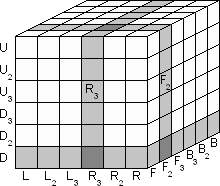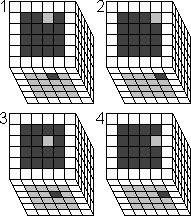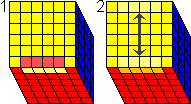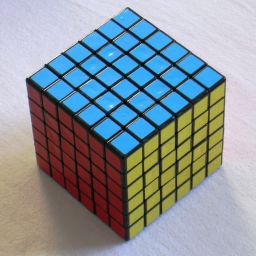This puzzle is a cube which is built from smaller cubes, 6 to an edge, i.e.
a 6×6×6 cube. Like a Rubik's Cube each slice can rotate, which
rearranges the small cubes on the surface of the puzzle. The six sides of
the cube are coloured, so every corner piece shows three colours, every edge
piece shows 2 colours, and every face centre only one.
Unlike the normal 3×3×3 Rubik's cube, turning a face does move the face
centres. The centres therefore can not be immediately used as a fixed
reference point.
The V-Cubes worldwide patent was granted to inventor Panagiotis Verdes on
2 December 2004, WO 2004 103497.
The number of positions:
There are 8 corner pieces with 3 orientations each, 24 inner edge pieces and 24 outer
edge pieces apparently with 2 orientations each, 24 centre corner pieces, two sets of
24 centre edge pieces, 24 inner centre pieces, giving a maximum of
8!·24!
6·3
8·2
48
positions. This limit is not reached because:
- The total twist of the corners is fixed (3)
- The edge orientation is dependent on its position, i.e. edges cannot actually be flipped (248)
- There are indistinguishable face centres (4!6·4)
- The orientation of the puzzle does not matter (24)
This leaves 7!·24!6·36 / 4!24 =
157,152,858,401, 024,063,281,013,959, 519,483,771,508,510, 790,313,968,742,344,
694,684,829,502,629, 887,168,573,442,107, 637,760,000,000,000, 000,000,000,000,000
= 1.57·10116 positions.
Like the normal cube, there are several types of solution. Here I will only give
the 'Edge-Matching' solution method.
Notation:
 Let the faces be denoted by the letters L, R, F, B, U and D (Left, Right
Front, Back, Up and Down). Clockwise quarter turns of a face layer are
denoted by the appropriate letter, anti-clockwise quarter turns by the
letter with an apostrophe (i.e. L', R', F', B', U' or D'). Half turns are
denoted by the letter followed by a 2 (i.e. L2, R2, F2, B2, U2 or D2).
The above is the same notation as for the 3×3×3 cube. An internal slice
will be denoted by adding a subscript 2 or 3. So F2 is a clockwise
turn of the slice immediately behind the Front face, and F3' is an
anti-clockwise turn of the slice immediately behind that. Note that these
denote a slice only, so such a move will not disturb the corners of the cube.
Let the faces be denoted by the letters L, R, F, B, U and D (Left, Right
Front, Back, Up and Down). Clockwise quarter turns of a face layer are
denoted by the appropriate letter, anti-clockwise quarter turns by the
letter with an apostrophe (i.e. L', R', F', B', U' or D'). Half turns are
denoted by the letter followed by a 2 (i.e. L2, R2, F2, B2, U2 or D2).
The above is the same notation as for the 3×3×3 cube. An internal slice
will be denoted by adding a subscript 2 or 3. So F2 is a clockwise
turn of the slice immediately behind the Front face, and F3' is an
anti-clockwise turn of the slice immediately behind that. Note that these
denote a slice only, so such a move will not disturb the corners of the cube.
The location of any piece can be denoted by listing the three faces/slices it lies in.
Solution
Phase 1: Solve centres
To do this phase, you must know where the colours of the cube are supposed
to be. If at any point you are unsure, look at the corner pieces to find
out. The method below solves the U centres without disturbing any already solved
faces. Simply repeat this for each of the faces.
- Find any centre piece edge that belongs on the U face. Hold the cube so that it
lies on the F or D face.
- If the piece is in the front face, turn F to put the piece at the
top right, i.e. in the U2 or U3 layer, and the R2
or R3 slice. If it is in the bottom face, turn D to put the piece at the
front right, i.e. in the F2 or F3 slice, and the R2
or R3 slice.
- Turn the U face so that there is an incorrect piece at the back right location where
the piece belongs.
 Do one of the following move sequences to insert the centre piece:
Do one of the following move sequences to insert the centre piece:
1. From F U2 R3 to U B2 R3: Do R3 U' L2' U R3' U' L2
2. From F U2 R2 to U B2 R2: Do R2 U' L2' U R2' U' L2
3. From F U3 R3 to U B3 R3: Do R3 U' L3' U R3' U' L3
4. From F U3 R2 to U B3 R2: Do R2 U' L3' U R2' U' L3
5. From D F2 R3 to U B2 R3: Do R32 U' L22 U R32 U' L22
6. From D F2 R2 to U B2 R2: Do R22 U' L22 U R22 U' L22
7. From D F3 R3 to U B3 R3: Do R32 U' L32 U R32 U' L32
8. From D F3 R2 to U B3 R2: Do R22 U' L32 U R22 U' L32
- Repeat a-d until all 16 centre pieces in the U face are correct.
- Repeat a-e for each of the faces.
 Phase 2: Match up the inner edges.
Phase 2: Match up the inner edges.
In this phase the inner edge pieces are matched up to form matching pairs.
- Find any inner edge piece that is not yet matched up with its twin inner edge piece.
Hold the cube so that this piece lies at the U B L3 location.
- Find the matching inner edge piece. Use any face moves to bring it to the U F R3 location.
- Find any unmatched inner edge pair and put them at the U R location, using only L/R/D face moves so
as not to disturb the other pieces. If there is no other unmatched pair, then do U2 R3 U2
R3 U2 R3 U2 R3 U2 R3 to make some new unmatched inner
edge pairs and try again.
- Do R3 B'RB R3' to pair up the inner edges.
- Repeat a-d until all inner edges are paired up.
 Phase 3: Match up the outer edges.
Phase 3: Match up the outer edges.
In this phase the outer edge pieces are matched up to the inner edge pairs.
- Find any outer edge that is not yet matched up with its inner edge pair. Hold the
cube so that this piece lies at the U F R2 location.
- Find the matching inner edge pair. Use any face moves to bring them to the U B location.
- Check that the inner edge pair shows a different colour on the U face than the outer edge piece.
If not, then flip over the inner edge pair by doing B' U R' U'.
- Find any other unmatched outer edge piece and put it at the U R B2location
without disturbing the other pieces. If there is no other unmatched pair, then do
U2 R2 U2 R2 U2 R2 U2 R2 U2 R2
to make some new unmatched outer edges and try again.
- Do R2 B'RB R2'
- Repeat a-e until all edges lie in matching edge quadruplets.
 Phase 4: Solve the cube.
Phase 4: Solve the cube.
- Solve the cube as far as possible by turning outer faces only, using any method for the 3×3×3 cube.
- There are two situations that can occur that are not possible on the
normal Rubik's cube, viz. a flipped 'edge', or two swapped 'edges'.
To solve the cube in these situations, you can use one of the
following sequences:
1. To flip the UF quad, do R1232 B2L U2 L23 U2 R23' U2 R23 U2 F2 R23 F2 L123' B2 R1232.
2. To swap the UF-UB quads, do U232 R232 U1232 R232 U2 R232.
If you end up with two swapped corners because your method solves the
corners last, then also swap two edges using the second sequence above, after which you
should be able to solve the cube again.



 Let the faces be denoted by the letters L, R, F, B, U and D (Left, Right
Front, Back, Up and Down). Clockwise quarter turns of a face layer are
denoted by the appropriate letter, anti-clockwise quarter turns by the
letter with an apostrophe (i.e. L', R', F', B', U' or D'). Half turns are
denoted by the letter followed by a 2 (i.e. L2, R2, F2, B2, U2 or D2).
The above is the same notation as for the 3×3×3 cube. An internal slice
will be denoted by adding a subscript 2 or 3. So F2 is a clockwise
turn of the slice immediately behind the Front face, and F3' is an
anti-clockwise turn of the slice immediately behind that. Note that these
denote a slice only, so such a move will not disturb the corners of the cube.
Let the faces be denoted by the letters L, R, F, B, U and D (Left, Right
Front, Back, Up and Down). Clockwise quarter turns of a face layer are
denoted by the appropriate letter, anti-clockwise quarter turns by the
letter with an apostrophe (i.e. L', R', F', B', U' or D'). Half turns are
denoted by the letter followed by a 2 (i.e. L2, R2, F2, B2, U2 or D2).
The above is the same notation as for the 3×3×3 cube. An internal slice
will be denoted by adding a subscript 2 or 3. So F2 is a clockwise
turn of the slice immediately behind the Front face, and F3' is an
anti-clockwise turn of the slice immediately behind that. Note that these
denote a slice only, so such a move will not disturb the corners of the cube.
 Do one of the following move sequences to insert the centre piece:
Do one of the following move sequences to insert the centre piece:
 Phase 2: Match up the inner edges.
Phase 2: Match up the inner edges.
 Phase 3: Match up the outer edges.
Phase 3: Match up the outer edges.
 Phase 4: Solve the cube.
Phase 4: Solve the cube.